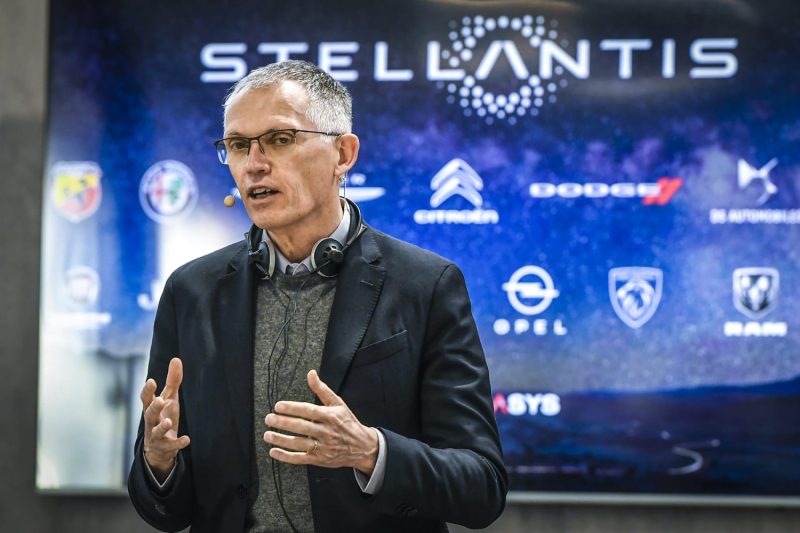Stellantis is correcting what CEO Carlos Tavares described Thursday as “arrogant” mistakes by himself and the company in the automaker’s U.S. operations that led to sales declines, bloated inventories and investor concerns.
Tavares said the convergence of three factors led to the problems: not selling down vehicle inventory fast enough; manufacturing issues, specifically with two unnamed plants; and lack of “sophistication in the way to go to market.”
“We had a convergence of three things that should have triggered, from me and nobody else, an immediate task force to address those things,” he told media Thursday after the company’s investor day at its North American headquarters. “When I’m saying that you are arrogant, I’m talking about myself. I’m talking about the fact that I should have acted immediately recognizing that the convergence of those three problems was there.”
During the investor day, Tavares and his top lieutenants broadly updated investors on the company’s operations and how Stellantis plans to achieve ambitious financial targets amid industry and economic uncertainty. The company also reconfirmed its 2024 guidance and vowed to continue to return capital to shareholders going forward.
Tavares did not elaborate on the manufacturing or go-to-market problems, but Stellantis’ inventory of vehicles leads major U.S. automakers as the company has held back incentives and cut marketing budgets. Stellantis’ U.S. sales were off 10% during the first quarter, leading to notable declines in revenue.
In May, Cox Automotive reported days’ supply of vehicles at Stellantis’ Jeep and Ram brands were more than twice the industry average of 76 days. Stellantis was the only major automaker to report a decline in U.S. sales last year; its market share dropped below 10%; and Hyundai, including Kia, outsold Stellantis for the first time ever.
While sales have been down, the company remains among the most profitable automakers globally. Since merging Fiat Chrysler and PSA Groupe to form Stellantis in 2021, the automaker’s adjusted operating income rose by 31% from 2021 through last year. Its adjusted profit margin is also up, rising 0.4 percentage point during that time frame, to 12.8%.
Stellantis reported a 12% decline in revenue in the first quarter, citing lower sales and foreign exchange effects, even as net pricing held firm. Its average vehicle transaction price in the U.S. was $57,266, according to Cox Automotive. That compares to an industry average of $48,389.
As part of the event, Tavares said Stellantis has achieved 8.4 billion euros ($9 billion) in cost reductions from the merger of Fiat Chrysler and PSA Groupe that created the company in January 2021.
That amount is more than double initial expectations from when the merger was announced in 2019, and an increase from the updated 5 billion euros in expected reductions within five years of completion of the merger, which formed one of the world’s largest automakers.
Tavares said the largest reduction was achieved in the sharing and consolidation of engineering assets for the company’s vehicles, followed by purchasing.
Cost-cutting has been a critical mission of the veteran automotive executive. Other cost-saving measures have included reshaping the company’s supply chain and operations, as well as head-count reductions.
Since the merger was agreed to in December 2019, Stellantis has reduced head count by 15.5%, or roughly 47,500 employees, through 2023, according to public filings. Additional job cuts this year involving thousands of plant workers in the U.S. and Italy have drawn the ire of unions in both countries.
Several Stellantis executives described the cuts to CNBC as difficult but effective. Others, who spoke on the condition of anonymity due to potential repercussions, have described them as grueling to the point of excessiveness.
The cuts are part of Stellantis’ strategic plan to increase profits and double revenue to 300 billion euros by 2030. The plan also includes targets such as achieving adjusted operating profit of more than 12% and industrial free cash flow of more than 20 billion euros.
“We are not looking for our way; we know where we are going,” Tavares said, referring to the automaker’s 2030 “Dare Forward” strategic plan.
Stellantis reconfirmed its 2024 guidance that included a double-digit adjusted operating income (AOI) margin, positive industrial free cash flow and at least 7.7 billion euros in capital return to investors in the forms of dividends and buybacks.
The automaker anticipates that Jeep will be a main driver for the company globally. Stellantis expects to grow sales of Jeep vehicles globally by 50% in the next three years, as the automaker attempts to leverage the quintessential American SUV brand for increased profits.
The trans-Atlantic automaker on Thursday said it will expand production and sales to roughly 1.5 million units by 2027. To do so, the company will grow its vehicle and powertrain offerings.
“The Jeep brand can be a local hero anywhere,” Tavares said. “We are going to reinforce the manufacturing footprint of Jeep.”







